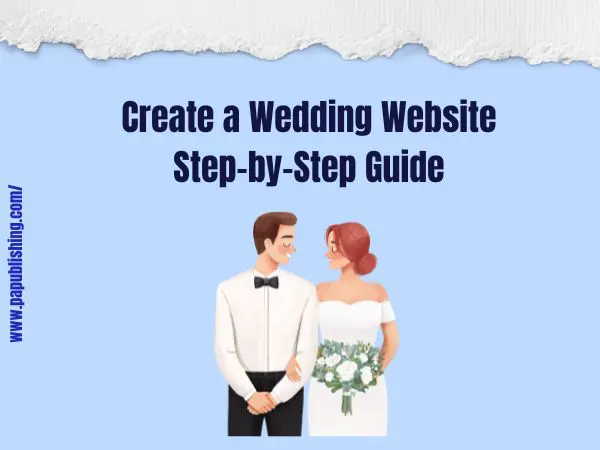How to Create a Wedding Website? With Examples
Planning a wedding can be very exciting yet overwhelming, with so much to do. To simplify things a little and make the whole process a bit more personal, create a wedding website. It’s a rundown of all the essentials in one single place, acting as a center for all guests of the wedding.
A wedding website is one of the most important facets of planning any modern wedding ceremony. It covers all vital information regarding the event and showcases the unique personality of the couple.
In this article, we’ll explore how to create a wedding website with examples, providing you with wedding website tips and inspiration.
Why Should You Create a Wedding Website?
Before you start creating your website, it’s essential to determine its purpose. You need to be clear on what you hope to achieve with it. Are you aiming to inform guests about the wedding details, showcase your love story, or create a central hub for all wedding-related information? Clearly defining your goals will help you focus on the content and design that best suits your needs.
Knowing the purpose of the website, draft what information you would like to share with your guests. This may include some essential details like reception location and registry but also some really personalized things about the event, like your love story. You can then carefully create a wedding website that’s both informative and engaging for your guests.
Benefits of Having a Wedding Website
A wedding website is a significant requirement for modern couples. It brings along countless advantages to smoothen the wedding event. Having a wedding website will alleviate much of the pressure associated with communication, allowing a one-stop area for information. Now, instead of dealing with so many texts and emails, you can easily post updates, answer frequently asked questions, and collect RSVPs with an accurate headcount.
Moreover, by creating a wedding website and private pages, you can share schedules, assignments, and important details with your guests. In short, this digital platform not only reduces stress but also ensures everyone is on the same page leading up to the big day.
How to Create a Wedding Website?
While a wedding website offers a fantastic way to capture your special day’s memories, building one shouldn’t be a stressful task. Even without tech expertise or endless free time, you can easily design a beautiful wedding website in just seven steps.
Step 1: Choose the Right Platform
To create a wedding website, start by selecting a platform that best suits your needs. Popular options include:
- Wix: This is a drag-and-drop platform with a user-friendly interface and many wedding-related templates.
- Zola: Zola is another wedding website creator that integrates with wedding registries. This makes it a convenient spot for both website creation and gift management.
- The Knot: This popular wedding website offers a variety of customizable templates and planning tools to make your wedding management easier.
When selecting a wedding website platform, consider your budget, and required features. Most platforms offer basic features for free, but premium plans often include extra perks like personalized web addresses and password-secured pages.
Step 2: Select a Template and Theme
Now, select one template (you can use Canva for it) that represents your wedding style and theme. From classic to rustic to modern, there is a template to choose from for every taste.
Whether you match your big day’s color scheme or focus on heartfelt photos, there’s a perfect template to complement your wedding vision.
Step 3: Designing Your Website
Visual appeal is the key to creating a memorable wedding website. To make your wedding website look amazing, pick colors and fonts that go well with the overall theme of your event. Invest in professional photography to ensure your website looks its best.
Moreover, keep a clean layout to make your website look organized. Also, aim for mobile optimization so that your website looks great on all devices.
Step 4: Personalize the Website
When you build a wedding website for your event, add personal elements to make it look unique. This includes engagement photos, your wedding story, etc. Here are a few wedding website tips for personalization:
- Add a Welcome Message
Greet your guests with a warm message that sets the tone of your wedding.
- Share Your Story
Tell your love story! Share with your guests how you met, your favorite things about each other, and why you’re excited to tie the knot.
- Introduce the Wedding Party
Give a shoutout to your groomsmen and bridesmaids with a formal introduction, their photos, and fun facts about them.
- Photos
Add pictures of the couple and their engagement photos. Also, introduce the family of both the bride and the groom and add their pictures, too.
- Fun Facts
Add a fun facts section where you mention quirky details about yourselves, your hobbies, likes and dislikes, and also pet peeves.
Step 5: Provide Website Must-Have Information for Guests
Once you’ve chosen your platform, found the right theme, and given a formal introduction to the couple and their family and friends, add the essential wedding-related information. To create a wedding website, these are the elements you need:
- Venue Information
Provide the key information the guests need about the reception venue. It’s even better if you add the directions to the given address or add a QR code of the location for people to scan.
- Schedule of Events
Add the timeline of events for your guests to know beforehand, how long will they be attending your wedding.
- Accommodation
Add a summary of accommodation options for the guest. Include the nearby hotels and transportation options.
- Dress Code
Make sure you correctly highlight the dress code of the event, to have a well-contrasted event.
- RSVP
Make it easy for guests to RSVP online through a built-in form or a link to the RSVP service page.
- Contact
Provide guests with a way to contact you through an email, form, or link to your social media profiles.
Step 6: Add Interactive Elements
Add some interactive elements that can enhance your guests’ experience. To create a wedding website, consider including:
- Photo Galleries: Here, you can showcase your engagement photos and, later, the bridal party and reception photos.
- Guestbook: Keep a digital guestbook where the guests can leave a message.
- Registry: Include links to a wedding registry for guests who want to celebrate with a wedding gift.
Step 7: Launch the Website and Keep It Updated
Once your website is complete, it’s time to share it with the world. But before launching and promoting your website, run some checks and trials. Make sure your wedding website is free of all typos and test if all links are working.
Once you’re set for the launch, share it on your social media platforms. Keep your website fresh and updated with new information and photos.
Wedding Website Examples
Here are some stunning examples of wedding websites that showcase different styles. You can take inspiration from these styles to create a wedding website.
Example 1: The Classic Wedding Website
A classic wedding website template typically features elegant fonts, neutral colors, and a minimalistic overall look. It’s perfect for fancy weddings with a formal tone. You can include a black-and-white photo gallery, a detailed schedule, and a heartfelt message to add a sophisticated look.
Example 2: The Modern Wedding Website
Modern wedding websites often use sleek, contemporary designs which add to the boldness. Such a website features a geometric layout, vibrant colors, and simple aesthetics. Highlight your wedding photos in a full-width slider and use a digital guestbook.
Example 3: The Rustic Wedding Website
Rustic wedding websites have a natural feel with earthy tones, vintage font and nature-inspired graphics. They’re perfect for an outdoor or barn setting. Use photos of your engagement shoot in natural settings and add a section for local attractions for guests.
Final Words
One of the best ways to get organized with your wedding planning is to have a great wedding website, not to mention involving your guests in the process. Following these steps will help you create a wedding website that not only meets the purpose but also depicts your story.



